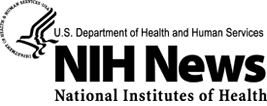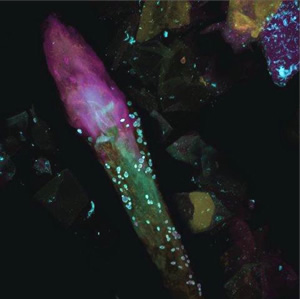Last updated:
NIH researchers conduct first genomic survey of human skin fungal diversity

NIH researchers conduct first genomic survey of human skin fungal diversity
Location on the body surface determines fungal composition with the greatest diversity on feet
Bethesda, Md., Wed., May 22, 2013 - While humans have harnessed the power of yeast to ferment bread and beer, the function of yeast or other types of fungi that live in and on the human body is not well understood. In the first study of human fungal skin diversity, National Institutes of Health researchers sequenced the DNA of fungi at skin sites of healthy adults to define the normal populations across the skin and to provide a framework for investigating fungal skin conditions.Human skin surfaces are complex ecosystems for microorganisms, including fungi, bacteria and viruses, which are known collectively as the skin microbiome. Although fungal infections of the skin affect about 29 million people in the United States, fungi can be slow and hard to grow in laboratories, complicating diagnosis and treatment of even the most common fungal skin conditions, such as toenail infections.
The research team from the National Human Genome Research Institute (NHGRI) and the National Cancer Institute (NCI), both parts of NIH, extended their recent genome sequencing study of skin bacteria, using DNA sequencing techniques optimized for identifying fungi. The study appears in the May 22, 2013 early online issue of Nature.
The researchers found that a single type of fungus, belonging to the genus Malassezia, is predominant on the head and trunk. Hands, which harbor a great diversity of bacteria, are home for relatively few types of fungi. In contrast, feet, including toenails, heels and toe webs contain tremendous diversity.
"Applying DNA sequencing to a study of the skin's fungi is the natural progression in understanding microbial life that co-exists on our bodies," said NHGRI Scientific Director Daniel Kastner, M.D., Ph.D. "Along with recent genome sequencing to define bacterial diversity, this analysis of fungal diversity provides a more complete human microbiome picture."
"Fungal communities occupy complex niches, even on the human body," said Heidi Kong, M.D., co-senior author and an investigator in the dermatology branch of NCI's Center for Cancer Research. "By gaining a more complete awareness of the fungal and bacterial ecosystems, we can better address associated skin diseases, including skin conditions which can be related to cancer treatments."
The researchers collected samples at 14 body sites from 10 healthy adults. DNA sequencing of the fungi in the samples identified fragments of DNA, called phylogenetic markers, which can be counted and used to distinguish one type of fungus from another. The sequencing efforts generated more than 5 million markers, from the samples, representing more than 80 fungal types, or genera. In contrast, traditional culturing methods produced 130 colonies of fungi that represented only 18 fungal genera.
In 20 percent of the study participants, the researchers observed problems such as heel and toe web scaling or toenail changes consistent with possible fungal infections. From genome sequencing analysis, the researchers found that different individuals with heel site infections have common fungal communities at that site, while those with toenail infections display tremendously different fungal communities.
"DNA sequencing reveals the great diversity of fungi, even those that are hard to grow in culture," said Julie Segre, Ph.D., co-senior author and senior investigator, NHGRI Genetics and Molecular Biology Branch. Her expertise is the development of microbial DNA sequencing technology. "DNA sequencing enabled us to learn immeasurably more about where fungi predominate as a part of the human skin microbiome."
The researchers identified fungi from two phyla, Ascomycetes and Basidiomycetes, as part of the normal fungal census at the 14 skin sites. The most common genus Malassezia was present in 11 of 14 sites sampled on the body. The researchers found Malassezia fungus on every skin surface of healthy volunteers, whether on the back of the head, behind the ears, in nostrils and on the heels. Heels were also home to many additional fungi, including the genera Aspergillus, Cryptococcus, Rhodotorula, and Epicoccum.
"DNA sequence-based methods of identification enabled us to differentiate among species of fungi and to conclude that the diversity of fungi is highly dependent on the body site rather than the person who is sampled," said Dr. Kong. A dermatologist, Dr. Kong explained why these sites were selected for exploration: "Our study focused on areas of the skin where we commonly find skin diseases that have been associated with fungi."The most complex site, the heel, is home to about 80 genus-level types of fungi. The researchers found about 60 types in toenail swab samples and 40 types in samples from the webs of the toes. Sites with moderate fungal diversity are inside the bend of the arm, inside of the forearm and palm, with each location supporting 18 to 32 genera of fungi. Surprisingly, head and trunk body sites - including the back, back of the neck, inside the ears, behind the ears, and between the eyebrows - have far fewer fungi types, with just two to 10 genera each.
The research team compared fungal diversity data with the skin bacteria on the same healthy adults. They found that while arms have high measures of bacterial diversity, they have lower fungal diversity. They found the reverse to be true for sites on the feet. Core body sites had neither a high bacterial diversity nor a high fungal diversity. The researchers had previously shown that bacterial diversity can be predicted by whether skin is moist, dry or oily. Fungal diversity, instead, seems to depend upon where a particular skin site is on the body.
The researchers observed, in addition, that there is greater similarity in the fungal community structure on the left and right sides of the same person's body compared to the same body parts on any two individuals. Fungal communities also appear to be quite stable over time, with little change when tested on two separate occasions, up to three months apart.
"The data from our study gives us a baseline about normal individuals that we never had before," Dr. Segre said. "The bottom line is your feet are teeming with fungal diversity, so wear your flip flops in locker rooms if you don't want to mix your foot fungi with someone else's fungi."
For fluorescent microscope images of fungi on the skin, go to http://goo.gl/eJakd.
NHGRI is one of the 27 institutes and centers at the NIH, an agency of the Department of Health and Human Services. The NHGRI Division of Intramural Research develops and implements technology to understand, diagnose and treat genomic and genetic diseases. Additional information about NHGRI can be found at its website, http://www.genome.gov.
NCI leads the National Cancer Program and the NIH effort to dramatically reduce the burden of cancer and improve the lives of cancer patients and their families, through research into prevention and cancer biology, the development of new interventions, and the training and mentoring of new researchers. For more information about cancer, please visit the NCI website at http://www.cancer.gov or call NCI's Cancer Information Service at 1-800-4-CANCER (1-800-422-6237).
The NIH Common Fund encourages collaboration and supports a series of exceptionally high impact, trans-NIH programs. Common Fund programs are designed to pursue major opportunities and gaps in biomedical research that no single NIH Institute could tackle alone, but that the agency as a whole can address to make the biggest impact possible on the progress of medical research. Additional information about the NIH Common Fund can be found at http://commonfund.nih.gov.
About the National Institutes of Health (NIH): NIH, the nation's medical research agency, includes 27 institutes and centers and is a component of the U.S. Department of Health and Human Services. NIH is the primary federal agency conducting and supporting basic, clinical, and translational medical research, and is investigating the causes, treatments, and cures for both common and rare diseases. For more information about NIH and its programs, visit http://www.nih.gov.
Contact
Raymond MacDougall
National Human Genome Research Institute
301-402-0911
macdougallr@mail.nih.gov
NCI Press Officers
301-496-6641
ncipressofficers@mail.nih.gov


